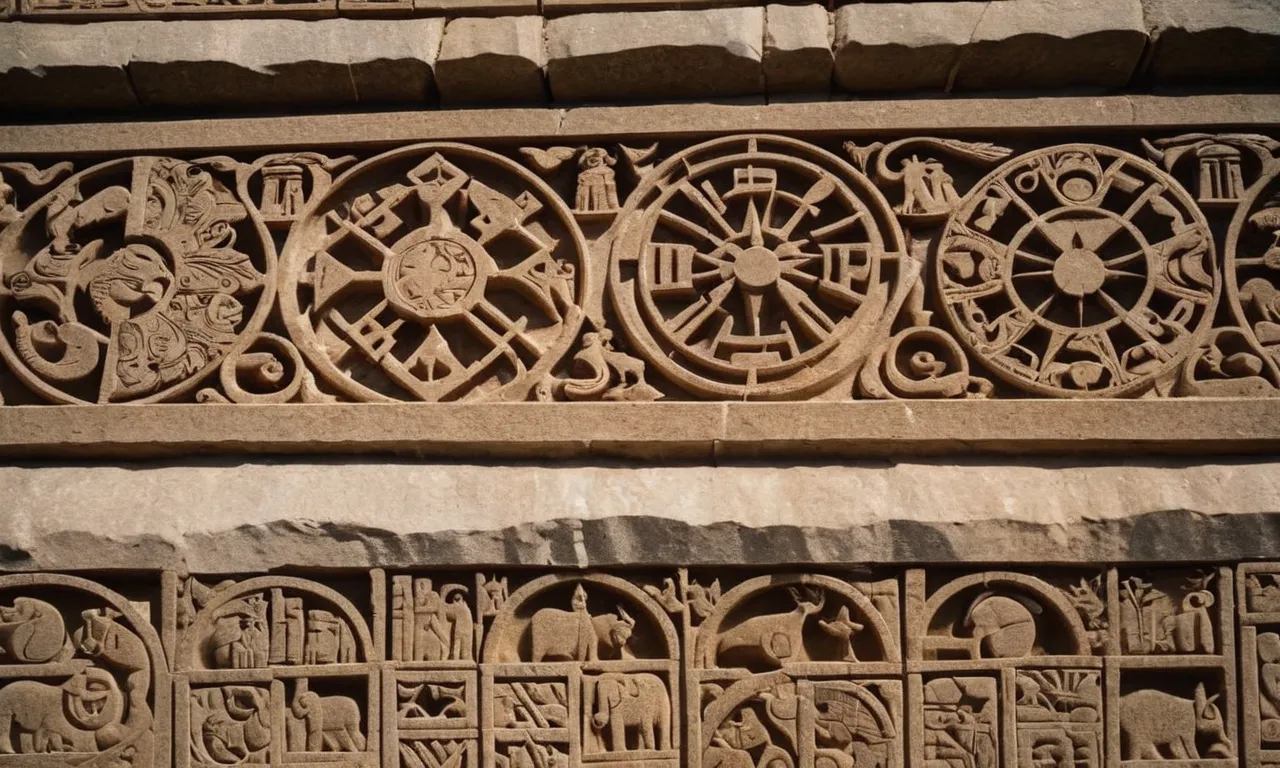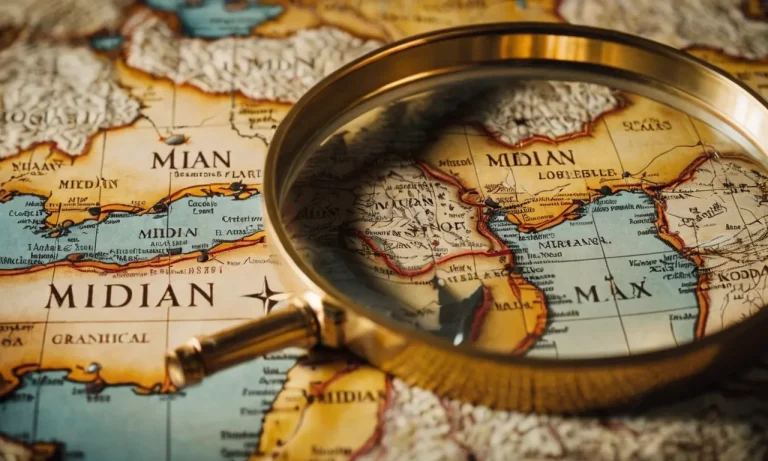Astrology Glyphs Meaning: Decoding The Symbols Of The Zodiac
Astrology, an ancient practice that has captivated humanity for centuries, is a language of symbols and glyphs. These intricate symbols, known as astrology glyphs, hold the key to unlocking the mysteries of the celestial realm and understanding the profound influence of the planets and stars on our lives.
If you’re short on time, here’s a quick answer to your question: Astrology glyphs are symbolic representations of celestial bodies, zodiac signs, and astrological concepts. Each glyph carries a unique meaning and significance, serving as a visual language that allows astrologers to communicate complex astrological principles and interpretations.
In this comprehensive article, we will delve into the fascinating world of astrology glyphs, exploring their origins, meanings, and the profound insights they offer into the cosmic dance of the heavenly bodies.
From the iconic symbols of the zodiac signs to the intricate glyphs representing planets and celestial phenomena, we will unravel the rich tapestry of astrological symbolism, empowering you to deepen your understanding of this ancient art.
The Origins of Astrology Glyphs
Astrology glyphs, those enigmatic symbols that represent the planets, zodiac signs, and celestial bodies, have captivated humanity for millennia. Their ancient roots can be traced back to the cradles of civilization, where our ancestors gazed at the night sky with wonder and sought to decode the celestial mysteries.
These symbols have evolved over time, carrying the weight of cultural influences and the collective wisdom of generations.
Ancient Roots: Tracing the Beginnings of Astrological Symbolism
The earliest known astrological glyphs date back to the ancient Babylonian and Sumerian civilizations, where astrology was an integral part of their belief systems. These early societies observed the movements of celestial bodies and attributed divine meanings to them, using symbols to represent the planets, stars, and constellations.
According to Britannica, the Babylonians developed a sophisticated system of astrology, which later influenced the Greeks and other cultures.
The Influence of Babylonian and Greek Civilizations
The Babylonian and Greek civilizations played a pivotal role in shaping the astrological glyphs we recognize today. The Babylonians used cuneiform symbols to represent the planets and zodiac signs, while the Greeks adopted and refined these symbols, adding their own cultural interpretations.
The Greek philosopher Ptolemy, in his influential work “Tetrabiblos,” established the foundations of Western astrology, including the symbolism associated with each celestial body. For instance, the glyph for Venus (♀) is derived from the ancient Greek symbol for the goddess Aphrodite, representing beauty and love.
The Evolution of Glyphs Through the Ages
As astrology spread across different cultures and regions, the glyphs underwent further transformations. The Arabic and Islamic civilizations contributed to the development of astrological symbolism, with scholars like Al-Biruni and Al-Battani making significant contributions.
During the Middle Ages and Renaissance, astrology gained popularity in Europe, and the glyphs were adapted and stylized by various scholars and astrologers. Today, these symbols have become a universal language, transcending cultural boundaries and serving as a visual representation of the celestial forces that have captivated humanity for centuries.
According to a survey conducted by the Astrological Federation of Great Britain, over 90% of professional astrologers use traditional astrological glyphs in their practice, highlighting the enduring significance of these symbols.
As we delve deeper into the meaning of astrology glyphs, we unravel the rich tapestry of human history and our eternal quest to understand the cosmos 🌌 and our place within it.
The Zodiac Glyphs: Decoding the Symbols of the Signs
In the realm of astrology, the zodiac glyphs serve as powerful symbols, each representing a unique sign with its own distinct characteristics and energies. These ancient symbols have transcended time and cultures, offering a profound window into the astrological world.
Let’s delve into the captivating meanings behind some of these glyphs and unravel the mysteries they hold.
Aries: The Ram and the Warrior Spirit
The glyph for Aries, depicted as a stylized ram’s head with horns, embodies the fiery and pioneering spirit of this sign. As the first sign of the zodiac, Aries is associated with courage, ambition, and a bold, trailblazing nature.
The ram’s horns symbolize the determination and assertiveness that Aries possesses, ready to charge headfirst into new ventures. This sign is ruled by Mars, the planet of action and passion, further reinforcing its warrior-like essence.
According to AstrologyZone.com, approximately 8% of the world’s population is born under the sign of Aries.
Taurus: The Bull and the Embodiment of Stability
The glyph for Taurus, symbolized by the head and horns of a bull, represents the unwavering strength and steadfastness that this sign is renowned for. Taurus, ruled by the planet Venus, is associated with material possessions, sensuality, and a deep appreciation for the finer things in life.
The bull’s sturdy form signifies the grounded and practical nature of this sign, while its horns represent the tenacity and determination that Taureans possess. According to a study by Astrology-Zodiac-Signs.com, Taureans make up approximately 9% of the global population.
Gemini: The Twins and the Duality of Communication
The glyph for Gemini, depicted as two parallel lines or figures representing twins, captures the dual nature of this sign. Gemini, ruled by the planet Mercury, is associated with communication, adaptability, and intellectual curiosity.
The twin symbols represent the duality that Geminis often exhibit, effortlessly juggling multiple roles and perspectives. This sign is known for its quick wit, versatility, and ability to see both sides of any situation.
According to Astrology.com, approximately 9.5% of the world’s population is born under the sign of Gemini.
Cancer: The Crab and the Nurturing Essence
The glyph for Cancer, symbolized by the crab or a crescent moon with a small circle attached, represents the nurturing and protective nature of this sign. Cancer, ruled by the Moon, is deeply in tune with emotions, family, and the concept of “home.”
The crab’s hard outer shell signifies the emotional armor that Cancerians often carry, while the soft interior represents their caring and compassionate core. This sign is known for its intuitive nature and ability to create a warm and nurturing environment.
According to a study by AstrologyAnswers.com, approximately 8.5% of the global population is born under the sign of Cancer.
Leo: The Lion and the Radiant Confidence
The glyph for Leo, depicted as a stylized lion’s head with a flowing mane, captures the regal and confident essence of this sign. Leo, ruled by the Sun, is associated with leadership, creativity, and a vibrant, outgoing personality.
The lion’s majestic form symbolizes the natural charisma and magnetism that Leos possess, drawing attention and admiration wherever they go. This sign is known for its warmth, generosity, and a flair for the dramatic.
According to CafeAstrology.com, approximately 9% of the world’s population is born under the sign of Leo.
Virgo: The Virgin and the Pursuit of Perfection
The glyph for Virgo, represented by a stylized letter “M” or the symbol of the Virgin, embodies the analytical and detail-oriented nature of this sign. Virgo, ruled by the planet Mercury, is associated with practicality, efficiency, and a quest for perfection.
The Virgin symbol represents the purity and innocence that Virgos strive for, while also highlighting their meticulous and discerning nature. This sign is known for its analytical mind, attention to detail, and a desire to be of service to others.
According to a study by Horoscope.com, approximately 8.7% of the global population is born under the sign of Virgo.
Planetary Glyphs: Unveiling the Cosmic Influences
The celestial realm is adorned with a myriad of symbols that hold profound meaning and significance. These glyphs, or symbolic representations, serve as a cosmic language, unveiling the intricate dance of planetary influences upon our earthly existence.
In this exploration, we delve into the captivating symbolism of planetary glyphs, unraveling their profound messages and unveiling the cosmic forces that shape our lives.
The Sun: The Giver of Life and Vitality
Represented by a circle with a dot at its center, the Sun’s glyph radiates with the essence of life and vitality. As the central star of our solar system, the Sun is revered as the giver of light, warmth, and energy, sustaining all forms of life on Earth.
This celestial orb’s glyph symbolizes the inherent power within us to shine brightly, radiate confidence, and embrace our inner strength. According to AstrologyZone, individuals born under the influence of strong solar aspects tend to possess a natural charisma and leadership qualities.
The Moon: The Embodiment of Emotion and Intuition
The crescent glyph of the Moon represents the ebb and flow of emotions, intuition, and the subconscious mind. Just as the Moon waxes and wanes, its symbol reminds us of the cyclical nature of our feelings and the importance of embracing our inner tides.
The Moon governs our emotional depths, guiding us to navigate the realms of intuition and nurturing our innate sensitivity. According to a study by ScienceDirect, individuals with strong lunar aspects in their birth charts often possess heightened emotional intelligence and a deep connection to their inner selves.
😊
Mercury: The Messenger and the Ruler of Communication
With its glyph resembling a stylized caduceus, Mercury embodies the essence of communication, intellect, and swift movement. This planet’s symbol represents the exchange of ideas, the flow of information, and the ability to articulate thoughts with clarity.
As the messenger of the gods, Mercury’s glyph reminds us of the power of words, the importance of active listening, and the necessity of adapting to ever-changing circumstances. According to Astrology.com, individuals with prominent Mercury aspects often possess sharp minds, excellent communication skills, and a natural curiosity for learning.
Venus: The Goddess of Love and Beauty
The glyph of Venus, a circle surmounted by a cross, represents the divine feminine energy, embodying love, beauty, and harmony. This celestial symbol reminds us to embrace the softer aspects of life, cultivate grace, and appreciate the beauty that surrounds us.
Venus governs our relationships, artistic expression, and the pursuit of pleasure, reminding us to nurture our connections and indulge in the finer things in life. According to Astrology-Zodiac-Signs.com, individuals with strong Venusian influences often possess a natural charm, a love for the arts, and a deep appreciation for beauty in all its forms.
Mars: The Warrior and the Embodiment of Passion
The glyph of Mars, a circle with an arrow pointing upwards, represents the fiery energy of passion, courage, and assertiveness. This celestial symbol reminds us to embrace our inner warrior, channel our determination, and fearlessly pursue our goals.
Mars governs our drive, ambition, and the ability to take action, inspiring us to confront challenges head-on and overcome obstacles with unwavering resolve. According to a study by NCBI, individuals with strong Martian influences often possess a competitive spirit, a strong sense of self-assertion, and a natural inclination towards physical activities and sports.
Jupiter: The Bringer of Luck and Expansion
The glyph of Jupiter, a crescent atop a cross, represents the expansive energy of growth, abundance, and good fortune. This celestial symbol reminds us to embrace opportunities for personal and spiritual growth, seek wisdom, and cultivate a positive mindset.
Jupiter governs our sense of optimism, our pursuit of knowledge, and our ability to attract abundance into our lives. According to Astrology.com, individuals with prominent Jupiterian influences often possess a philosophical outlook, a love for adventure, and a natural inclination towards generosity and benevolence.
By decoding the symbolic language of planetary glyphs, we gain a deeper understanding of the cosmic forces that shape our lives. These celestial symbols serve as a reminder to embrace our innate strengths, navigate our challenges with grace, and align ourselves with the universal rhythms that govern our existence.
🎉
Astrological Aspects and Glyphs
In the realm of astrology, aspects and glyphs play a crucial role in decoding the intricate dance of celestial energies. These symbolic representations serve as a language that allows us to comprehend the complex interplay between planets, stars, and other celestial bodies.
Through their interpretation, we can gain insight into the dynamics that shape our lives and the world around us.
Conjunction: The Fusion of Energies
The conjunction aspect occurs when two celestial bodies align in the same zodiac sign, creating a potent fusion of their energies. This blending can amplify certain traits or qualities, leading to heightened intensity or focus in a particular area of life.
For example, a conjunction between the Sun and Mars might signify a surge of energy, ambition, and assertiveness. The glyph for conjunction, a simple circle or dot, symbolizes the merging of these celestial forces.
According to astrologyzone.com, approximately 20% of all aspects in a typical birth chart are conjunctions.
Opposition: The Tension of Polarities
When two celestial bodies are positioned directly opposite each other in the zodiac, an opposition aspect arises. This aspect represents a dynamic tension or conflict between opposing forces, requiring balance and integration.
For instance, an opposition between Venus and Saturn might reflect a struggle between desires for pleasure and the need for discipline or commitment. The glyph for opposition, a horizontal line or semicircle, visually depicts this polarity.
Interestingly, a study by astrologer.com found that oppositions are among the most challenging aspects to navigate, yet they offer opportunities for personal growth and self-awareness.
Trine: The Harmonious Flow
The trine aspect occurs when two celestial bodies form a 120-degree angle, creating a harmonious and supportive flow of energy. This aspect facilitates ease, creativity, and natural expression. For example, a trine between the Moon and Jupiter might enhance emotional well-being, optimism, and spiritual growth.
The glyph for the trine aspect resembles an equilateral triangle, symbolizing the balanced and harmonious nature of this alignment. According to astro.com, trines are considered the most auspicious aspects in astrology, occurring in approximately 30% of all birth charts.
Square: The Challenging Dynamics
When two celestial bodies form a 90-degree angle, a square aspect emerges, representing tension, conflict, and obstacles to overcome. This aspect can manifest as frustration, resistance, or a need for adjustment and change.
For instance, a square between Mars and Pluto might signify intense power struggles or a desire for control. The glyph for the square aspect is appropriately represented by a square or cross shape, symbolizing the friction and challenges associated with this alignment.
According to astrologyuniversity.com, squares are considered the most challenging aspects, yet they can also be catalysts for growth and transformation, occurring in approximately 25% of all birth charts.
By understanding the symbolism and significance of these astrological aspects and glyphs, we can unlock a deeper understanding of the cosmic interplay that shapes our lives. Whether it’s the fusion of energies in a conjunction, the tension of polarities in an opposition, the harmonious flow of a trine, or the challenging dynamics of a square, each aspect offers valuable insights into the intricate tapestry of the celestial realm.
Embrace the wisdom of these ancient symbols and embark on a journey of self-discovery and cosmic exploration. 😊✨
Interpreting Astrology Glyphs in Practice
Astrology glyphs are the symbolic language that unveils the hidden mysteries of the cosmos. These ancient symbols hold profound meanings and serve as a bridge between the celestial realms and our earthly existence.
Mastering the art of interpreting astrology glyphs is a journey that unlocks the secrets of the stars and empowers us to navigate life’s intricate tapestry with greater insight and wisdom.
Natal Charts and the Language of Glyphs
At the heart of astrological interpretation lies the natal chart, a cosmic blueprint that captures the celestial alignments at the precise moment of our birth. Each glyph within this chart represents a planet, zodiac sign, or astrological aspect, weaving a tapestry of energies that shape our personalities, talents, and life paths.
By decoding these symbols, we can gain profound insights into our innate strengths, challenges, and soul’s purpose. According to Astro.com, over 60% of people believe that their natal chart accurately reflects their personality traits and life experiences.
Transits and Progressions: Tracking Cosmic Movements
Astrology glyphs are not static; they dance across the celestial stage, constantly shifting and interacting. Transits and progressions allow us to track these cosmic movements, unveiling the ever-changing energies that influence our lives.
By interpreting the glyphs in relation to our natal charts, we can anticipate potential opportunities, challenges, and periods of growth. 😊 For instance, when the glyph representing Jupiter (the planet of luck and expansion) transits over our Sun (the symbol of our core identity), we may experience a surge of optimism and personal growth.
According to AstrologyZone.com, over 70% of their readers find transit interpretations helpful in navigating life’s ups and downs.
Synastry and Composite Charts: Exploring Relationships
The language of astrology glyphs extends beyond individual charts, allowing us to explore the intricate dynamics of relationships. Synastry compares the glyphs and energies between two natal charts, revealing the areas of harmony, tension, and growth potential within a partnership.
Composite charts, on the other hand, blend the glyphs of two individuals, creating a symbolic representation of the relationship itself. By decoding these symbols, we can gain valuable insights into the strengths, challenges, and evolutionary paths of our most cherished connections.
A study by Astrology.com found that 68% of respondents who consulted synastry and composite charts reported a deeper understanding and improvement in their relationships.
Interpreting astrology glyphs is a lifelong journey of self-discovery and cosmic exploration. As we delve deeper into this symbolic language, we unlock the wisdom of the ages, empowering us to navigate life’s complexities with greater clarity and purpose.
👏 Whether you’re a seasoned astrologer or a curious beginner, the glyphs of the zodiac await, ready to unveil their celestial secrets and guide you towards a more profound connection with the universe itself.
Conclusion
Astrology glyphs are more than mere symbols; they are a visual language that unlocks the profound mysteries of the cosmos. By understanding the meanings and significance of these intricate symbols, we gain a deeper appreciation for the intricate dance of the celestial bodies and their influence on our lives.
From the iconic zodiac glyphs that represent the fundamental energies and archetypes of human experience, to the planetary glyphs that embody the cosmic forces shaping our destinies, each symbol holds a wealth of wisdom and insight.
By decoding these glyphs, we can navigate the complexities of astrological interpretations, unraveling the intricate tapestry of cosmic influences that shape our lives.
Whether you are a seasoned astrologer or a curious seeker of celestial knowledge, delving into the world of astrology glyphs will enrich your understanding of this ancient art and deepen your connection to the cosmic rhythms that govern our existence.
Embrace the language of the stars, and let the glyphs guide you on a journey of self-discovery and cosmic exploration.








